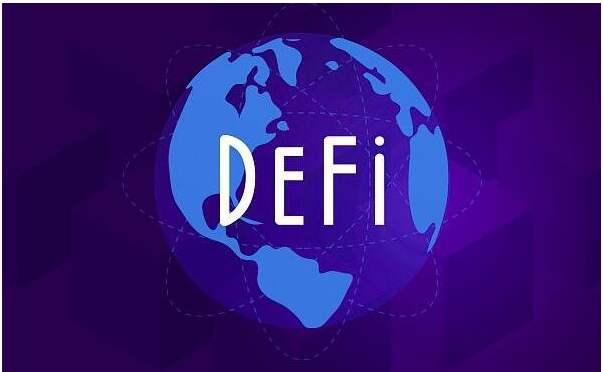"APY Addiction": The DeFi Aftermath Left by AC
Original author: 0x137/Rhythm BlockBeats
Last weekend, the soul figure of the DeFi space, Andre Cronje, liquidated all his assets in the Fantom ecosystem and announced his departure from the DeFi and crypto space. The Fantom ecosystem responded with a drop, experiencing an extreme "roller coaster" ride in token prices and TVL within just a few months.
In fact, DeFi had already shown obvious signs of fatigue before AC's departure. Solidly was supposed to be his opportunity to revitalize DeFi, but it ultimately ended in failure. What exactly went wrong with DeFi? How should it develop in the future?
The Departure of a Leader
Yield Optimization "Addicts"
After AC exited the crypto industry, several articles emerged introducing his life, most of which listed the "hardcore" development career of this DeFi leader. However, people seemed to forget his strong interest in financial yield optimization. Throughout his crypto career, this seems to have been his obsession.
Before becoming famous, AC would always seek optimal yield strategies on lending platforms like Aave and Compound, constantly jumping between these platforms. However, this approach not only incurred high gas fees but was also very time-consuming, so AC wrote this process of finding optimal yields into code, naming it iearn. To make the code more accurate, more people needed to participate and perform more deposit and withdrawal operations, and thus Yearn was born.
This was a simple yield optimizer; by depositing assets, the platform would automatically execute the optimized yield strategy for users. Although later versions introduced liquidity mining in collaboration with DEXs like Uniswap and more complex YFI Tokens, the core idea of Yearn remained very simple: to provide users with the simplest and most optimized financial services. In AC's view, "Deposit And Forget" is the spirit and soul of DeFi products.
SOLID: Andre Cronje's Waterloo
After the "Curve phenomenon" emerged, AC once again saw hope for DeFi. He wanted to combine the potential of veToken and the liquidity model of protocols to revitalize DeFi. In early January, AC published three articles in one day, outlining the vision for his new project ve(3,3), instantly stirring the previously silent DeFi community.
ve(3,3), or what is now Solidly, is also a yield optimizer. By holding more SOLID Tokens, users can vote for their liquidity pools and earn higher yields (Rhythm note: Solidly is detailed in "What is ve(3,3) that AC is desperately promoting?").
Solidly was supposed to be AC's crowning achievement, but it ultimately became his Waterloo.
Everything seemed to go wrong from the collaboration with Daniele Sesta. The latter is the founder of Frog Nation and another soul figure in the DeFi space; his creations Abracadabra.money and Wonderland once single-handedly supported the TVL of the Avalanche ecosystem.
This was a strong alliance, with Daniele responsible for Solidly's promotion and public relations, while AC continued to focus on development. The combination of Frog Nation and Yearn's ecosystem power would undoubtedly overshadow any OG protocol.

AC's Twitter background image after the official announcement of the collaboration, with AC on the left and Daniele on the right
But what no one expected was that Frog Nation dropped the ball at a critical moment.
On January 27, Frog Nation's CFO 0xSifu was exposed for allegedly participating in multiple fraud schemes, causing the community to erupt once again (Rhythm note: This incident is detailed in "Frog turns into F 'rug', a billion-dollar panic event triggered by a tweet"). AC, who had been relatively inactive on social media, immediately responded on Twitter, accusing Daniele of negligence. At this point, AC was already showing clear signs of fatigue.
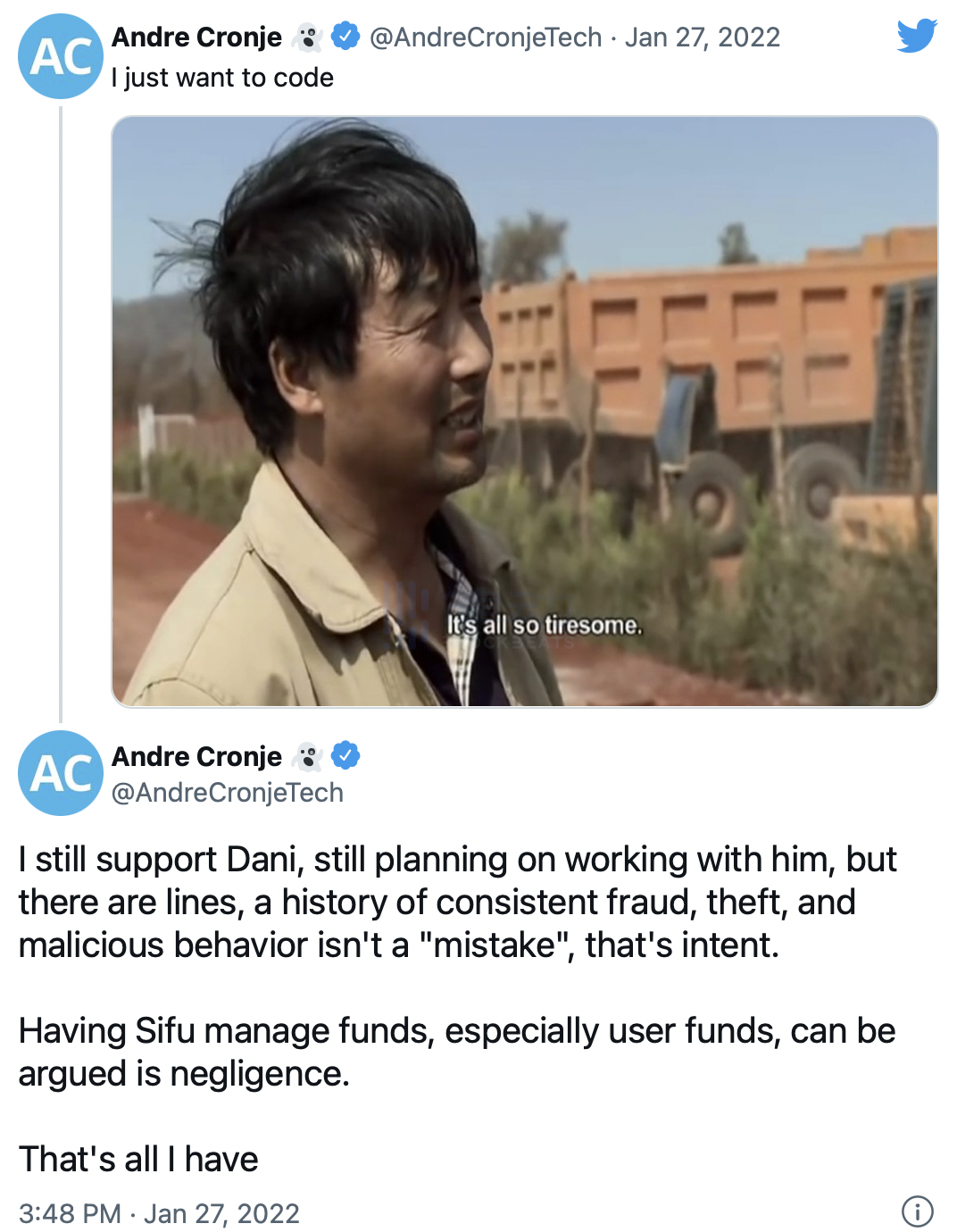
Ultimately, Daniele had to withdraw from Solidly's development to return to his own backyard to put out fires. Although this incident did not severely impact Solidly, and Fantom's TVL continued to soar, Daniele's departure laid the groundwork for Solidly's failure.
It is important to note that AC had no experience in public relations and was often "missing" on social media. After Daniele's departure, AC had to handle both public relations and development alone. More importantly, the original ecosystem collaboration had now turned into a solo performance by AC and the Fantom ecosystem, and people knew that relying solely on Fantom's native protocols to support DeFi was nearly impossible.
This issue had actually begun to show signs before Solidly's launch. To obtain the initial allocation of SOLID Tokens, the protocol's TVL had to rank in the top 20, but the originally relatively good competition became chaotic due to the interference of the external protocol veDAO.
Various alliances and vampire attacks emerged, and the protocol began to offer increasingly outrageous APYs to compete for TVL, with no one willing to focus on product development anymore. However, instead of correcting this behavior in a timely manner, AC exacerbated the situation by encouraging TVL competition, which led to a lot of resentment among users of Fantom's native protocols.
After Solidly officially launched, the development team's problems were fully exposed. Front-end bugs led to a poor user interaction experience, liquidity pool vulnerabilities caused many to lose significant funds, and severe congestion on the Fantom network filled AC's Twitter with complaints.
Under the pressure of the project's poor performance and community sentiment, AC deleted his Twitter account and ultimately chose to leave the DeFi and crypto world.
What Went Wrong with DeFi?
"APY Addiction"
As the soul figure who initiated DeFi Summer, AC and his Yearn Finance seemed to have implanted the idea of "pursuing APY" into DeFi from the very beginning. While the concept itself is not wrong, like many things, a good idea can also lead to unexpected consequences.
In the early days of DeFi, mainstream protocols like Aave and dYdX provided truly decentralized and convenient financial services for the masses, without their own tokens, focusing on product innovation and experience optimization.
However, it wasn't long before Compound pushed a new wave, namely liquidity mining. By offering its own COMP token, Compound was able to provide higher APRs to liquidity providers on the platform. In no time, Compound's market share surged, and the DeFi landscape began to shift.
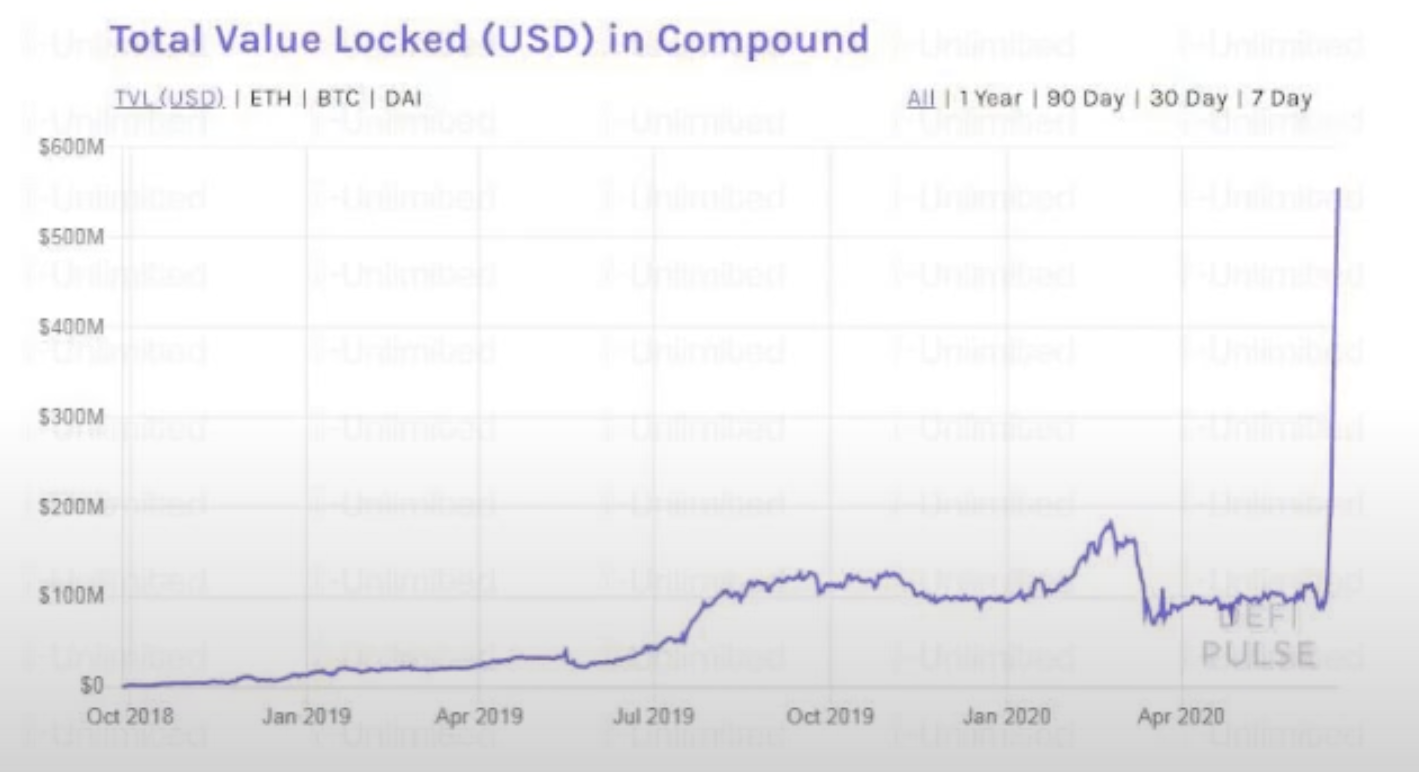
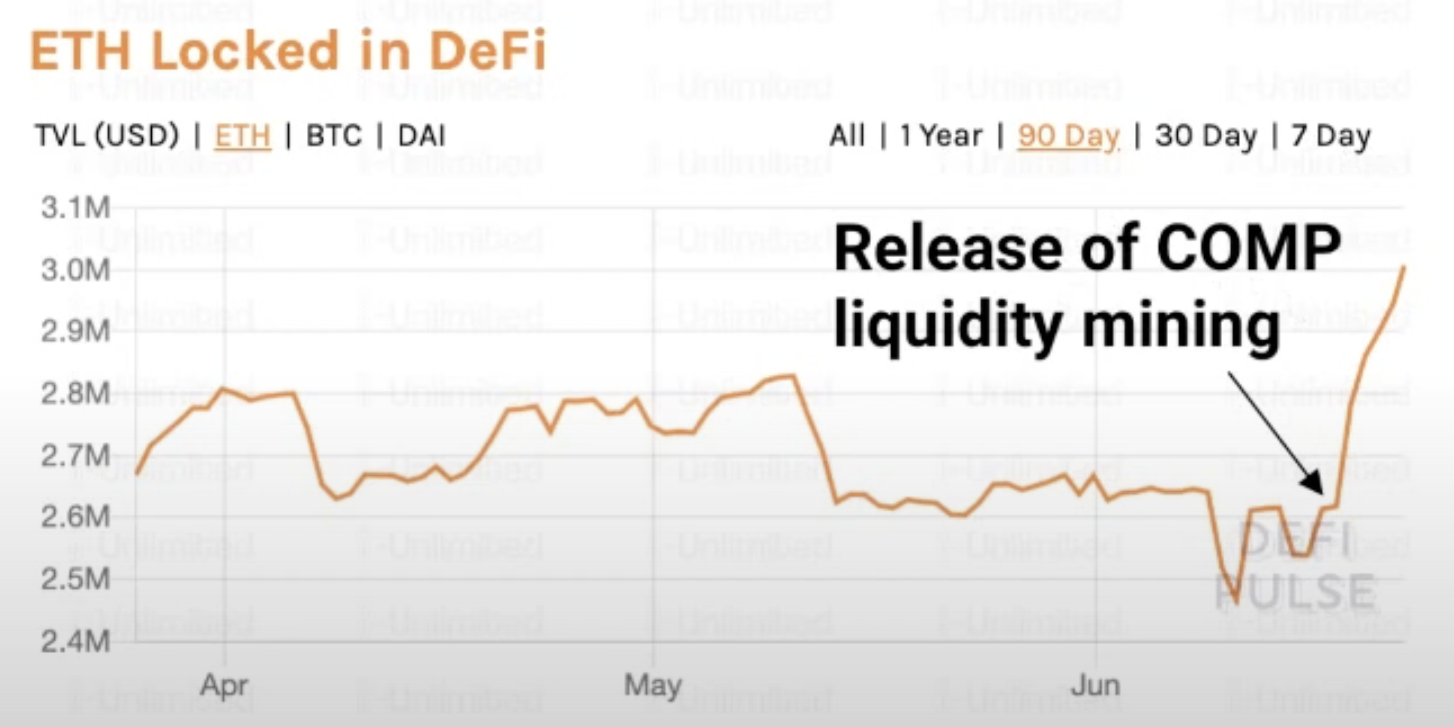
After announcing COMP liquidity mining, Compound's TVL rapidly soared in a short period
Then came the rise of DEXs like Uniswap, which were specifically designed for trading tokens, and liquidity mining became the mainstream model for launching protocols. From this point on, DeFi's dependence on APY deepened, leading it down a path of no return.
To address the "mining disaster" caused by liquidity fleeing in DeFi 1.0, protocols like Olympus in 2.0 offered higher and more sustainable APYs. However, the 2.0 model of DeFi protocols had clearly become very extreme.
For DeFi 1.0 protocols, acquiring liquidity was meant to facilitate decentralized market trading, but 2.0 protocols lacked any practical scenarios and resembled a Ponzi scheme. The so-called "protocol-controlled liquidity" became a way for teams to quickly amass funds, even leading to significant rug pulls (Rhythm note: DeFi 2.0 is detailed in "APY 70,000%, dominated by OHM forks").
With the rise of the Curve War and the veToken model, the APY war also ensnared itself, with protocols competing not for application scenarios and user experience, but for higher APY "bribes."
The failure of Solidly was largely due to this vicious APY competition. Protocols like veDAO, without bringing any substantial innovation to DeFi, simply relied on higher APYs to capture a large amount of TVL from Fantom's native protocols. This phenomenon dealt a significant blow to teams that were genuinely focused on development and opened the door for more speculative projects.
Since the rise of liquidity mining, DeFi has gradually taken a wrong turn. The problems that protocols aimed to solve are no longer about providing users and the industry with more stable and convenient financial services, but rather about how to offer higher APYs and obtain higher TVLs; users no longer view DeFi as a source of stable income but as a speculative channel. What new protocols aim to achieve is no longer important; as long as the APY is high enough, they rush in without hesitation.
Compared to a year ago, today's DeFi has become chaotic, turning into an APY "addict."
Token Empowerment
Alongside liquidity mining, the "Token culture" in the DeFi space was born, but unlike public chains, finding value empowerment for their own tokens has always been a major issue troubling DeFi protocols.
For DeFi 1.0 applications like Uniswap, tokens are tools used by protocols to attract liquidity. Liquidity providers supply liquidity to trading pools and earn the protocol's native tokens as rewards. This model initially produced significant effects but soon exposed its drawbacks. As users of the protocol, they actually do not need the protocol's tokens; in other words, these native tokens cannot capture and share the value and income generated by the platform.
Taking dYdX as an example, users' daily contract trading operations have nothing to do with the DYDX token, which is limited to governance voting, interaction discounts, and other "insignificant" aspects. Therefore, for liquidity providers, the native token does not have long-term holding value, and mining and selling has become a routine operation for whales. Once APYs begin to decline, these "mercenary" capitals will flee, leading to a "mining disaster."
To solve this problem, DeFi 2.0 simply turned tokens into the protocol itself; users must hold the protocol's tokens to use it. However, to ensure higher and more sustainable APYs, the dilution of the tokens themselves has become even more extreme.
The biggest problem with DeFi 2.0 is that it lacks practical utility. The protocol resembles a Ponzi scheme, relying on continuously flowing funds to provide "backing" for the protocol and create false APYs for token holders. The token price is entirely dependent on users' trust in the promise of "protocol backing." But we know that this backing has never occurred, and the token price ultimately plummeted, making 2.0 the shortest-lived version of DeFi.
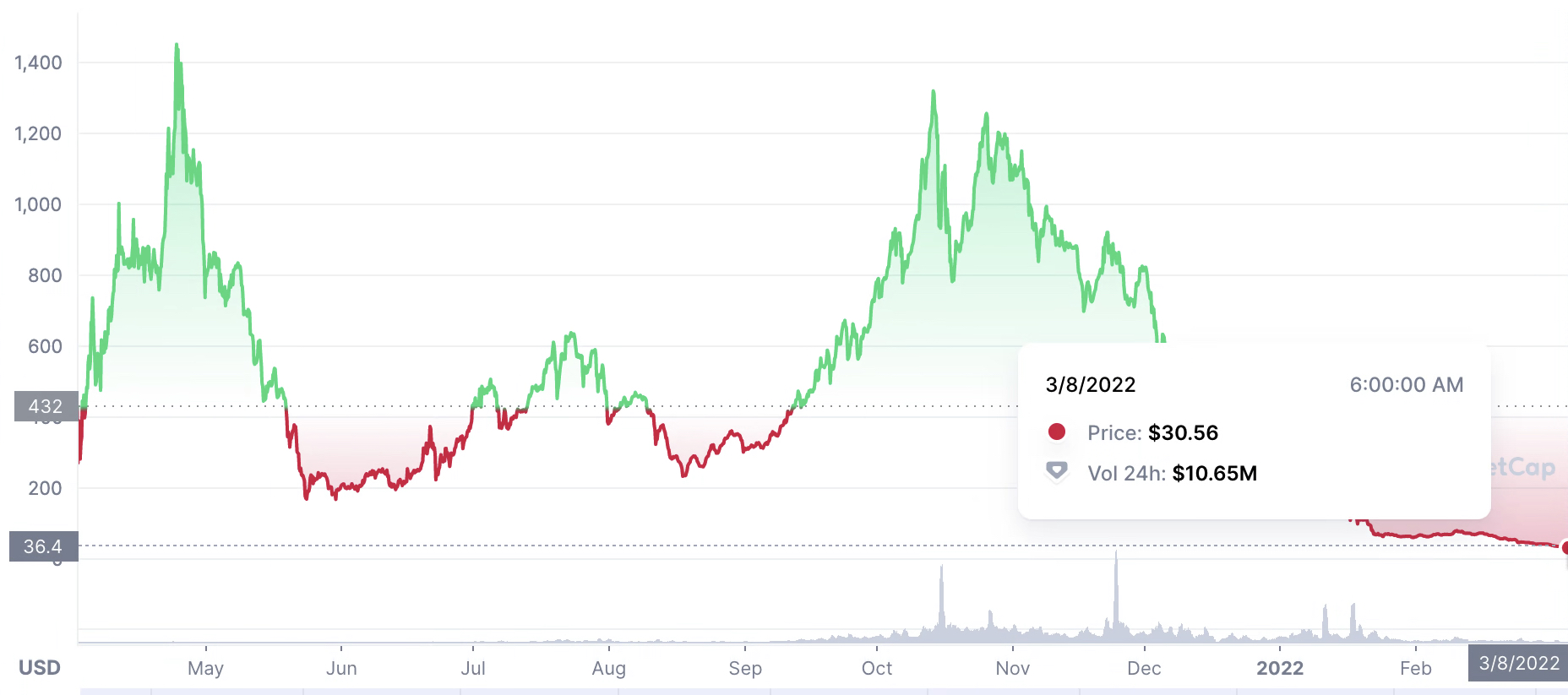
Price chart of Olympus's native token OHM, which has dropped 98% from its peak
After the Curve War gained traction, the issue of token empowerment was somewhat resolved. By granting yield voting rights to locked veTokens, tokens gained some practicality for liquidity providers, but the value empowerment brought by this practicality remains limited.
Taking Curve as an example, although holding more veCRV can bring higher APYs for liquidity providers, the yield is ultimately settled in CRV, which must either be locked or sold, serving no other purpose. In other words, the veToken model is merely to alleviate the selling pressure of the native token and still cannot capture the value of the protocol itself.
In fact, AC himself has publicly questioned the necessity of the "Token culture" for DeFi. Indeed, even without tokens, DeFi protocols can provide users with convenient financial services.
It is not that DeFi protocols cannot have tokens; the essence of "Token culture" is that users holding tokens can own a part of the network and capture the value created by the network's growth through tokens. But as it stands, the tokens of DeFi protocols have not achieved this.
Caesar is Gone, Who Will Inherit the DeFi Banner?
AC's departure has left a void in DeFi but has also helped clear away a lot of sediment from this space. Although no one knows how DeFi will develop in the future, this event allows us to reflect on what kind of DeFi is sustainable and valuable. Perhaps his departure will become another turning point in the development of DeFi.
LUNA: Growing Amidst Doubts
LUNA has long been viewed by many as a Ponzi scheme or "air token," but whether during the previous panic market or this AC exit event, Terra's DeFi ecosystem has withstood the test without being significantly affected. Indeed, Terra does face the risk of a "death spiral," but its true value is something many have overlooked.
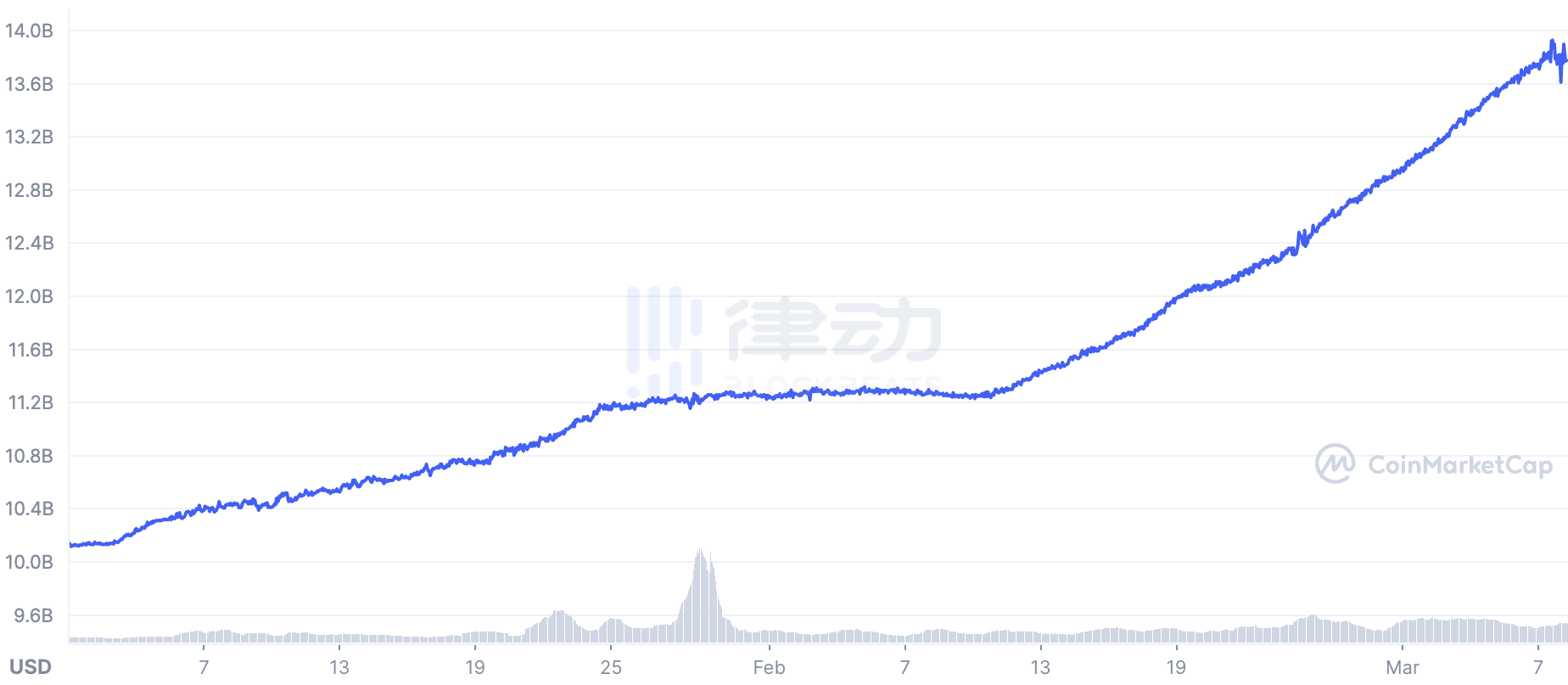
UST's market cap has been steadily rising
What Terra is doing is improving the payment process for e-commerce through blockchain technology. For a long time, there has been a natural barrier between the crypto world and the real world, as token prices are too volatile to be truly applied in real life; thus, stablecoins have become an important tool to bridge these two worlds.
However, unlike most stable protocols, Terra genuinely considers the strong regionality of fiat currencies. Its stablecoin system is actually a rich combination of currencies, pegged to various fiat currencies, and meets the needs of different regions and scenarios through real applications within the ecosystem, including the US dollar, South Korean won, Thai baht, and more.
Off-chain, CHAI Pay helps businesses and individuals connect over 20 payment channels, including wire transfers, local gateways, and credit cards, saving a significant amount of time and costs; on-chain, users can gain exposure to trading US stocks through Mirror. Various investment needs within the Terra ecosystem ultimately flow back to UST, capturing the value created by the network in the form of LUNA Tokens for holders.
In the early days of DeFi Summer, the success of OG projects like Compound, Aave, Yearn, and Curve was due to their commitment to providing accessible financial services for the general public, which is what the market and a broad audience truly need and what can create real value. Terra's success today follows the same principle.
"DeFi is Not a One-Person World"
DeFi, and even the entire crypto space, is still filled with a cult of personality. From this perspective, AC's departure is a good thing; it leaves more room for other developers to grow and makes the entire industry more rational.
After Andre's exit, the Fantom Foundation issued a statement: "Fantom has never been a one-person team."

Members of Yearn Finance acknowledged the contributions of the team on Twitter and stated that they would continue to bring more innovative products to DeFi in the future.

The community also stepped up at a critical moment to maintain essential infrastructure.

The future development path of DeFi is never limited to one; what matters is that more developers are willing to contribute silently to this field, and fortunately, this is exactly what we are witnessing.



